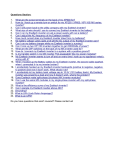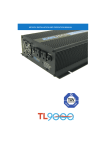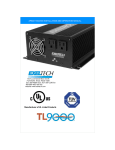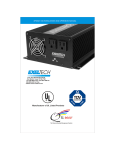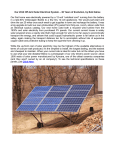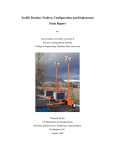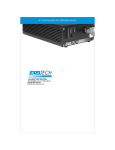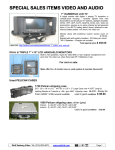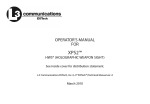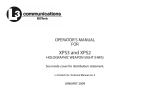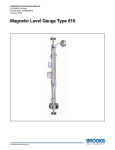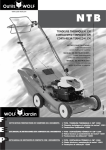Download Amtex XP600 Specifications
Transcript
XP600/1100 INSTALLATION AND OPERATION MANUAL XP SERIES INVERTERS DC/AC Sine Wave Inverters: 125 - 1100 Watts Specifications Features • • • • • • • • True sine wave output Will power all types of loads State of the art switched mode design High MTBF>180,000 hours DC input options: 12V, 24V, 32V, 48V, 66V & 108V Frequency options: 50, 60 and 400HZ Output options: 100, 120, 230 VAC Overload, thermal and overvoltage protection The XP series inverters provide the best regulated true sine wave inverters on the market. Reliable, lightweight and with input options from 12V to 110DC. With distortion of <2%, the XP inverters are designed to provide smooth, clean, continuous AC power without noise and spikes which could affect todays high tech electronic equipment. They will also operate any type of load, making them the ideal inverter in AC standby power applications for telecommunications, industrial and other commercial applications. Model Selection XP Power 12VDC 24VDC 32VDC 48VDC 66VDC 108VDC AC WAVEFORM: Sinusoidal HARMONIC DISTORTION: Typically 1.5%, maximum 2% OUTPUT VOLTAGE: 100V, 120V or 230VAC options FREQUENCY: 50HZ, 60HZ or 400HZ options FREQUENCY REG: Regulation ±0.1% OUTPUT POWER: 125 to 1100 watts. Refer to table SURGE POWER: Typically 2.2 times rated output (except 125W units and 250W) EFFICIENCY: Typically 88% at rated load REGULATION LINE: Typically 0.1% maximum 0.5% REGULATION LOAD: Typically 3% maximum 5% OPERATING TEMPERATURE: -25°C to 40°C at rated power HUMIDITY: 5% to 95% non condensing ALTITUDE: -200ft to 10,000ft operating AUDIBLE NOISE: Less than 45dbA COOLING: Convection cooled 125 - 250W models. Thermostatically controlled forced air 600 - 1100W models EMC: EN55014 DIMENSIONS (WHD) & WEIGHT: XP125: Output VAC Power Code: Out VAC code: Input VDC code: 2 INPUT VOLTAGE: (Typical range) Input VDC 118 x 51 x 172mm XP250: 265 x 70 x 135mm XP600: 196 x 92 x 300mm XP1100: 196 x 92 x 375mm Frequency 1 = 125W (not with 230V) 2 = 250W 6 = 600W K = 1100W 1 = 12VDC 2 = 24VDC B = 32VDC 3 = 36VDC 4 = 48VDC E = 66VDC I = 110VDC Frequency code: 5 = 50HZ 6 = 60HZ 4 = 400HZ eg. XP6 - 3 - 4 - 5 = Input 48VDC Output 230VAC 50HZ, 600W 0.9kg. 3.0kg 4.5kg. 4.5kg. PROTECTION (Automatically reset):* * OVER VOLTAGE: * UNDER VOLTAGE: 0 = 100VAC 1 = 120VAC 3 = 230VAC (10.5 - 16.5) (21.0 - 33.0) (28.0 - 44.0) (42.5 - 62.0) (58.0 - 91.0) (95.0 - 149.0) * THERMAL: Shutdown at maximum input voltage condition. Shutdown at minimum input voltage condition. Shutdown at 105°C internal temperature, warning buzzer at approximately 5°C before shutdown. OUTPUT PROTECTION: Unit will shutdown in event of output short. OUTPUT CABLE: P190BK050683 - converts IEC output plug, to Australian plug. XP SERIES INVERTERS DC/AC Sine Wave Inverters: 125 - 1100 Watts XP1100 XP600 XP250 8 XP125 All dimensions in inches 3 XP600/1100 INSTALLATION AND OPERATION MANUAL XP600/1100 INSTALLATION AND OPERATION MANUAL Table of Contents Introduction 1.0 page 3 Standard Features 2.0 page 5 Installation 3.0 page 8 Operation 4.0 page 11 Appendix A page 12 Appendix B page 14 Page 5 XP600/1100 INSTALLATION AND OPERATION MANUAL Introduction 1.0 Thank you for purchasing the finest sine-wave inverter in the power conversion industry. The journey to excellence includes the first affordable sine wave inverter, first modular inverter system, first N+1 redundant inverter system, and the cleanest sine wave output in the industry. We strives to manufacture products of the highest possible quality, and is dedicated to 100% customer satisfaction. Proudly built in the USA with American parts, Committed to TL 9000 standards and beyond, adding people and procedures continually to further improve quality and customer service. . XP series inverters provide the cleanest, best regulated sine wave output over the widest DC input of any inverter on the market today. They are extremely low in Total Distortion; specified to 2%, and typically better than 1.5%. Total Harmonic Distortion is typically 0.8 to 0.9%. Remaining distortion is a result of residual switching noise, which amounts to a very clean 25 KHZ sine wave superimposed on the fundamental output. No significant harmonics of 25 KHZ exist. This spectral purity will exist over the inverter's entire operating envelope, including non-linear and reactive loads. As long as peak output current remains less than 300% of rated current, total harmonic distortion will remain within the 2% spec. Peak current capability of the inverter is key to understanding it's operational envelope. As long as the inverter is supplying less than this amount, it will function properly and operate virtually any load. . Many inverters are rated in Volt-Amps (VA), as opposed to Watts. This is in an attempt to make an inverter or UPS (Uninterruptible Power Supply) appear larger than it really is. The only fair way to Page 6 XP600/1100 INSTALLATION AND OPERATION MANUAL specify these products is in Watts (W), which is power the inverter can actually deliver. If the XP inverters were specified in VA, Our 1100 Watt inverter could be rated at 1375 VA at .8 power factor, 1570 VA @ .7 pf, or an incredible 2200 VA @ .5 pf. It is confusing to specify a product in VA, because the power factor must also be specified. XP-Series inverters can output their full rated o power continuously at 40o C . The inverter can maintain a spectrally pure output with any load, due to a specially designed non-linear control loop in the primary DC to DC converter. This circuitry is one of three circuits which protect the inverter from any overload condition. . XP-600 and XP-1100 . These inverters can supply twice their rated output power for 3 seconds, in order to start motors or supply in-rush currents to electronic loads. If output power is exceeded for greater than 3 seconds, output voltage is reduced to a level which will provide the inverter’s rated power to the load by clipping tops of the waveform. The inverter can operate safely in this mode indefinitely. Should the overload condition clear, the inverter will again provide the cleanest Sine Wave in the industry. This over-current circuitry insures maximum peak current does not exceed 300% of rated RMS current. Should this number be exceeded, it will again reduce output voltage as required to maintain that limit. Again, the inverter can operate in this mode indefinitely, so that when the overload clears, output voltage is automatically restored. The third protection mechanism is short circuit. If the inverter exceeds it’s peak current (Ip) capacity for a prolonged period, it will shut off automatically. The period of time required to shut off changes with the degree of overload. A high overload shuts off in one second. A slight overload may require several seconds. This typically requires a .5 ohm load per 1000 Watts, for several seconds. This guarantees the inverter is disabled, in the event that the user attempts to clear the short without first shutting off the inverter. The inverter in fact, acts as an extremely high performance circuit breaker. The short circuit and overload circuitry responds much faster than any normal fuse or breaker, so no external current limiting devices are necessary. XP-Series inverters can output their full rated power continuously at 40o C. The inverter is derated 20% of its Page 7 XP600/1100 INSTALLATION AND OPERATION MANUAL full power for every 10 degrees C over 40 degress C. IE; 80% of normal capacity at 50 degrees C. . . . etc. . Standard Features 2.0 DC INPUTS: Positive (+) and Negative (-) input terminals are 5/16" studs with brass hardware. They are accessed under the Rear Cover. Use Appendix “A” to choose the appropriate gauge wire for your specific model. . REMOTE ON/OFF: provides the User with a remote method to turn the inverter on and off. “REMOTE” connection is on the barrier terminal strip located under the Rear Cover. . AC OUTPUTS: All models (*except 230 VAC output) have two, NEMA -15 outlets (standard wall receptacle), located on the Front Panel. Additionally; may be hard-wired to appliance / load using connections on the barrier terminal strip, located under Rear Cover. * XP-1100, XP-600 230 VAC, inverters have an IEC-320 receptacle located on the Front Plate. . COOLING: is provided by a thermostatically controlled brushless fan located on the Front Panel. . DC POWER ON LED: located on the front panel, will be "ON" when inverter is powered up, and DC power is available. . LOW BATT / THERM BUZZER: produces an audible alarm if DC input voltage falls to a level within 2% to 4% of the low limit of inverter, or, if there is an over temperature condition. . Page 8 XP600/1100 INSTALLATION AND OPERATION MANUAL ON/OFF SWITCH: located on front panel; turns the inverter on and off. . OVER VOLTAGE PROTECTION: If input voltage to the inverter exceeds set limits, the inverter will immediately and without warning shut off. When input voltage returns to normal range, the inverter will immediately restart. Since high over voltages tend to have very fast edges, the inverter must shut down quickly to protect itself. This kind of fault usually occurs if the battery is suddenly disconnected from the system and the battery charger continues to supply current. UNDER VOLTAGE PROTECTION: When battery voltage falls to within 2% to 4% of low line voltage, the LOW BATT / THERM buzzer will sound. If the condition continues without reducing load to the inverter or adding charge to the battery, the inverter will shut off. When voltage rises to approximately 95% of nominal battery voltage, the inverter will turn back on and the alarm condition will clear. The inverter can be manually reset by cycling the on/off switch. This will reset the protection circuit and turn the inverter on at any voltage above minimum voltage. . OVER TEMPERATURE PROTECTION: The inverter is also protected against overheating. It will provide its full rated output up to the temperature listed in the specification sheet. If it is subjected to higher ambient temperatures or air circulation is blocked, the inverter may overheat. If the LOWBATT/ THERM buzzer sounds, immediate action is required or the inverter will shut down. Either reduce load, or provide more cooling in the immediate environment. If no action is taken, the inverter will likely shut down within 2 minutes. When the inverter shuts down, the alarm condition will persist and the cooling fan will continue to run. Since the inverter has eliminated its load, it will cool fairly quickly. It will automatically restart when it has cooled sufficiently, and the LOW BATT/THERM alarm will clear. “105 C internal temperature. Warning buzz 5 C before shut off”. . OVERPOWER, SHORT CIRCUIT PROTECTION: The inverter has three levels of overpower protection. The first limits peak instantaneous current. The second system limits absolute power coming from the module. Both of these circuits act to reduce output Page 9 XP600/1100 INSTALLATION AND OPERATION MANUAL voltage as required, to limit current to a safe level. The overpower protection circuit will recover instantly when the overpower condition clears. The third, is short circuit protection. If the over current condition is so severe that it causes output voltage to collapse to 1 Vp for more than 1 second, the inverter will shut down and not automatically restart. This requires the user to clear the short circuit safely, and guarantee that hazardous voltage will not come back on line until desired. To reset the inverter from this condition, cycle power switch “OFF” then “ON” again. . Page 10 XP600/1100 INSTALLATION AND OPERATION MANUAL Installation 3.0 CAUTION: It is essential to read and understand all Warnings, Cautions, and Notes before any connections are made to the Unit or System. If further assistance is needed call (817)595-4969 and ask for Customer Service. . WARNING: The inverter is designed to operate from a Battery. Performance cannot be guaranteed, and damage can result when a charger or power supply is used without a battery in the circuit. . WARNING: The AC neutral lead is internally bonded to chassis; chassis must be bonded to earth ground through the external ground connector that is located on the unit. The Negative or Positive terminal of the battery (DC Source) must be bonded to earth ground; it is recommended that it be to the same earth ground used for AC ground. Refer to the figure below for wiring illustration. . (A) A) Positive earth ground B) Negative Earth Ground + *Note: Only “A” or “B” NOT BOTH. Battery Inverter + - (B) CAUTION: Before any connections are made to the Unit or System, be sure to disconnect the battery terminals. Always disconnect the grounded battery terminal first. When re-connecting, connect ungrounded terminal first, and grounded terminal last. . Page 11 XP600/1100 INSTALLATION AND OPERATION MANUAL CAUTION: Polarity of leads is critical to avoid damage to the unit or system. Check batteries and battery cables for correct polarity and voltage. . CAUTION: Observe all National and Local Electric Codes when connecting AC Power Connections. . INSTALLATION (Location) . Mounting location is critical to performance and life span of the inverter. Heat and Moisture are the two worst enemies of any electronic device. Therefore, when choosing a mounting location, consider the following requirements listed in order of importance: 1. Inverter must be sheltered from the elements. Select a clean, dry location. . 2. Inverter requires adequate ventilation for cooling. With proper cooling, the inverter will operate efficiently and meet its published ratings. All models can be mounted in several positions. Best position, with fan down. Second best, horizontal. Third, vertical with fan up. Least preferred, upside down. . 3. Inverter should be mounted as close to the battery as possible. Shorter wire has less resistance, which translates to increased efficiencies. . INSTALLATION (Wiring) . An in line fuse is recommended, to protect the battery and wiring to the inverter. This fuse should be located very close to the battery positive (+) terminal. To select appropriate size fuse, consult the . "Rated and Peak Current" table in appendix "B". XP-600 and XP-1100: Positive (+) and Negative (-) input terminals are 5/16" studs with brass hardware. They are provided under the Rear Cover. Use Appendix “A” to choose the appropriate gauge wire for your specific model and distance from the battery. 1. Disconnect the grounded (-) terminal of battery and make sure the . charger and inverter are off. Page 12 XP600/1100 INSTALLATION AND OPERATION MANUAL 2. Make DC input connections to the inverter as illustrated in . Appendix “C”. 3. (Optional) Using 12-18 AWG wire, make Remote On/Off connection from the Rear Panel terminal labeled “REMOTE” to one pole of a small toggle switch. Then from the other pole of . toggle switch, make a connection to battery negative (-). 4. Make sure the toggle switch is off. . Note: in order for the Remote On/Off switch to operate inverter, . On/Off switch on the Front Panel must be off. 5. If the Appliance / Load will be hard wired to the inverter instead of, or in addition to, using the outlets provided on the Front Panel, see . Appendix “C”. Page 13 XP600/1100 INSTALLATION AND OPERATION MANUAL Operation 4.0 TURN ON INVERTER: . XP-600 and XP-1100: Turn inverter on using Toggle Switch on Front Panel, or the "REMOTE" switch if installed. LED next to the switch will illuminate, indicating the inverter is operational. . Note: If using "REMOTE" switch, the Front Panel Switch must be off. (If either switch is "on", the inverter will turn on. Both switches must be off for the inverter to turn off.) . TURN ON APPLIANCE/LOAD: . 1. Check Input Power Requirements of the appliance. Make sure that it is less than Rated Output Power of the inverter. If more than one appliance will be run simultaneously, the sum of their Input Power Requirements must be less than Rated Output Power of the inverter. . 2. If Appliance/Load has been hard wired to the barrier terminal strip as illustrated in Appendix "B", then turn appliance on. Otherwise; 3. Plug the appliance into the provided receptacle on Front Panel, then turn appliance on. . Note: It is recommend that the inverter be turned ON before the . appliance/load. Page 14 XP600/1100 INSTALLATION AND OPERATION MANUAL APPENDIX A Input Power Requirements: MODEL NORMAL VDC MINIMUM VDC CUT-OFF / ALARM MAXIMUM VDC RATED PEAK CURRENT CURRENT XP-600 / 12VDC 13.8 VDC 10.4 / 10.6 VDC 16.5 VDC 58.8 A 66.6 A XP-600 / 24VDC 27.6 VDC 19 / 21 VDC 33 VDC 29.4 A 33.6 A XP-600 / 48VDC 55.2 VDC 41.5 / 42.5 VDC 62 VDC 14.7 A 16.6 A XP-600 / 66VDC 75.9 VDC 57.5 / 58.5 VDC 91 VDC 10.7 A 12.1 A XP-600 / 108VDC 124.0 VDC 94 / 95 VDC 149 VDC 6.5 A 7.4 A XP-1100 / 12VDC 13.8 VDC 10.4 / 10.6 VDC 16.5 VDC 107.8 A 122.1 A XP-1100 / 24VDC 27.6 VDC 19 / 21 VDC 33 VDC 53.9 A 61.6 A XP-1100 / 48VDC 55.2 VDC 41.5 / 42.5 VDC 62 VDC 27 A 30.5 A XP-1100 / 66VDC 75.9 VDC 57.5 / 58.5 VDC 91 VDC 19.6 A 22.1 A XP-1100 / 108VDC 124.0 VDC 94 / 95 VDC 149 VDC 12 A 13.6 A Recommended Input Wire Sizes (For Variable Distances from the Battery): MODEL LESS THAN 5’ LESS THAN 10’ LESS THAN 15’ LESS THAN 20’ XP-600 / 12VDC 4 AWG 0 AWG 0 AWG 00 AWG XP-600 / 24VDC 10 AWG 6 AWG 4 AWG 4 AWG XP-600 / 48VDC 16 AWG 12 AWG 10 AWG 10 AWG XP-600 / 66VDC 18 AWG 16 AWG 14 AWG 12 AWG XP-600 / 108VDC 18 AWG 18 AWG 18 AWG 16 AWG XP-1100 / 12VDC 0 AWG 00 AWG 0000 AWG 0000 AWG XP-1100 / 24VDC 6 AWG 4 AWG 2 AWG 0 AWG XP-1100 / 48VDC 12 AWG 10 AWG 8 AWG 6 AWG XP-1100 / 66VDC 16 AWG 12 AWG 10 AWG 10 AWG XP-1100 / 108VDC 18 AWG 16 AWG 14 AWG 14 AWG Note: The table specifies standard wire sizes (not smaller than 18 AWG) that will provide less than a 2% voltage drop at Low-line Input voltage and Rated Output Power. See page 13 for Mechanical dimensions and mounting hole locations. Page 15 XP600/1100 INSTALLATION AND OPERATION MANUAL APPENDIX A TOP 12.100 XP600 9.342 8.897 0.125 DIA. 4 PLCS .281 3.565 FRONT 7.315 7.690 0 .375 1.280 .780 0 SIDE 3.565 0 0 7.690 0 12.100 0 TOP 15.050 XP1100 12.345 11.842 0.125 DIA. 4 PLCS 1.280 .780 0 FRONT 3.565 7.315 7.690 0 .375 .281 SIDE 3.565 0 Page 16 15.050 0 7.690 0 0 XP600/1100 INSTALLATION AND OPERATION MANUAL APPENDIX B Note: Use Rated Current and voltage in Appendix "A" to select an appropriate Toggle Switch or Relay for your specific model inverter. XP-600 and XP-1100 with DC Toggle Switch: + DC Toggle Switch (See Appendix A) Battery + - Inverter - XP-600 and XP-1100 with DC Relay: Normally Open Contacts + Battery DC Toggle Switch (Low Current) Relay Coil + Relay - Inverter - INSTALLATION . CAUTION: Be sure to disconnect all DC power to installation wiring. Be sure to disconnect batteries and chargers. Make all connections to the inverter BEFORE connecting DC leads to the battery. . REMOTE LINE NEUTRAL GROUND XP-600 and XP-1100 Rear View with access cover removed (AC/DC Connections): BAT BAT + Page 17 ADDENDUM FOR X20, X27, & X28 OPTIONS (XP600 AND XP1100) GENERAL The X20, X27, and X28 option provides for an alarm contact OR an AC transfer switch on EXELTECH XP Series inverters. The alarm relay monitors the inverter’s AC output and will energize the alarm contact when the inverter fails to produce AC. The AC transfer switch can be configured in two ways (via jumpers) 1. Inverter as the primary source of AC power. 2. Utility as primary source of AC power. CAUTION: “ ANY OPTION THAT USES TRANSFER SWITCH IS NOT AUTHORIZED FOR USE IN LAND MOBILE APPLICATIONS ” NOTE: All secondary AC power sources other than the inverter will be referred to as utility. A secondary source of AC power includes utility, “shore power”, generator, etc. When the primary source of AC power fails, the transfer switch “switches” to its secondary source of AC power in 50ms or less. When the primary source of power is present again (turns back on), the transfer switch “switches” back to the primary source of power in 50ms or less. Page 13 of 17 BAT+ & BAT- 5/16 in. stud mount for battery input, be careful to observe proper polarity. CHAS Chassis or earth ground (green wire) should be connected here. NEUT Neutral or return line (white wire) of the AC output. INVOUT Hot or AC output of the inverter (black wire). NO Normally open contact of the relay. When the “COIL” terminal is energized, this contact is connected to “C” (common terminal). When the “COIL” terminal is not energized, this contact is not connected to “C” (common terminal). C The common terminal of the relay. NC Normally closed contact of the relay. When the “COIL” terminal is energized, this contact is not connected to “C” (common terminal). When the “COIL” terminal is not energized, this contact is connected to “C” (common terminal). RMT Remote terminal. Applying battery negative to this terminal will turn the inverter ON. Use a switch connected to battery negative and the remote terminal to turn on the unit remotely. This terminal has no significant current demand. UTIL When utility AC power is connected to the “NO” terminal, this terminal can be used with a jumper to energize the “COIL” when utility is on. COIL The coil contact of the relay. This must be connected to the INV terminal to function as an alarm and can have either UTIL or INV jumpered to it to function in a transfer switch. INV A low current output of the inverter voltage to drive the relay. INSTALLATION CAUTION: Be sure to disconnect all DC power to the installation wiring. Be sure to disconnect both the batteries and the chargers which may be connected. Make all connections to the inverter BEFORE connecting DC power to the battery. Page 14 of 17 ALARM CONTACT CONFIGURATION -X27 OPTION The alarm contact is configured via jumpers on a removable terminal plug on the back of the inverter 1. Remove the terminal plug from the inverter by hand or with needle-nose pliers. On the underside of the plug are screw terminals to set connections. (The terminal plug can take up to 12GA wire.) 2. Insert a jumper between COIL and INV. (see drawing) When the inverter is on, the alarm relay will energize. If it is desired to sense the AC voltage elsewhere in the system such as after a circuit breaker, remove the jumper between COIL and INV and connect the AC hot from the point you want to sense to the COIL contact. 3. Connect alarm signal input wire (supplied by operator) to “C” (common) contact. Connect alarm signal output wire to either NO (normally open) or NC (normally close) contacts. OPERATION When Battery voltage is available to the inverter, the inverter will turn “on” when the front panel switch is turned “on” OR when the RMT (remote) terminal is connected to battery negative. When the inverter comes “on” the alarm relay will energize and there will be continuity between the NC (normally open) and “C” (common) contacts of the relay terminals. Inverter AC output will be available from the NEMA 15 terminals in the front (plug) and at the output terminals in the rear of the inverter (terminals marked INVOUT for AC hot, NEUTRAL for AC return, and CHASSIS for ground). To shut “off” the inverter the front switch must be turned “off” AND the remote switch must be in the “off” position. Page 15 of 17 TRANSFER SWITCH CONFIGURATION The AC transfer switch is configured via jumpers on a removable terminal plug on the back of the inverter. NOTE: When using the transfer switch option, you must utilize the AC output contacts on the back of the inverter. The transfer switch will not work if used with the NEMA 15 connectors (plug) on the front of the inverter. INVERTER AS PRIMARY SOURCE OF AC POWER -X28 OPTION “ X28 OPTION IS NOT AUTHORIZED FOR USE IN LAND MOBILE APPLICATIONS ” 1. Remove the terminal plug from the inverter by hand or with needle-nose pliers. On the underside of the plug are screw terminals to set connections. (The terminal plug can take up to 12GA wire.) CAUTION: 2. Insert a jumper between INVOUT and NO, then insert a jumper between COIL and INV. (see drawing) 3. Connect your load to the LOAD (AC hot) contact, NEUTRAL (AC return), and CHASSIS (AC ground) contacts. 4. Connect utility power to the NC (Utility hot), NEUTRAL (Utility return), and CHASSIS (Utility ground) contacts. OPERATIONS: When Battery voltage is available to the inverter and the front panel switch is turned “on” OR when the remote terminal is connected to battery negative, the inverter will turn “on”. When the inverter AC power fails, the transfer switch “switches” to utility AC power in 50ms or less. When the inverter AC power is present again (turns back on), the transfer switch “switches” back to the inverter AC power in 50ms or less. Page 16 of 17 UTILITY AS PRIMARY SOURCE OF AC POWER -X20 OPTION CAUTION: “ X20 OPTION IS NOT AUTHORIZED FOR USE IN LAND MOBILE APPLICATIONS ” 1. Remove the terminal plug from the inverter by hand or with needle-nose pliers. On the underside of the plug are screw terminals to set connections. (The terminal plug can take up to 12GA wire.) 2. Insert a jumper between INVOUT and NC, then insert a jumper between COIL and UTIL. (see drawing) 3. Connect your load to the LOAD (AC hot) contact, NEUTRAL (AC return), and CHASSIS (AC ground) contacts. 4. Connect utility to the NO (Utility hot), NEUTRAL (Utility return), and CHASSIS (Utility ground) contacts. OPERATIONS When Battery voltage is available to the inverter and the front panel switch is turned “on” OR when the remote lead is connected to battery negative, the inverter will turn “on”. When the utility AC power fails, the transfer switch “switches” to inverter AC power in 50ms or less. When the utility AC power is present again (turns back on), the transfer switch “switches” back to the utility AC power in 50ms or less. C:\data\robert\wpwin\john's_XP_manual\XPmanual_rev1_1_hp2100.wpd May 30, 2001 (2:55pm) Page 17 of 17























